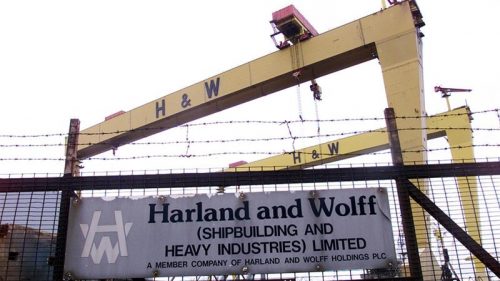
Harland and Wolff, the Belfast shipyard that built the Titanic, was put into administration on Monday after its bankrupt Norwegian owner failed to find a buyer and calls for its nationalization were rebuffed.
The shipyard, whose towering yellow cranes dominate the Northern Irish city’s skyline, has been occupied by workers fearful for their jobs since last week. They said on Monday they would block administrators from entering the site.
“BDO have been appointed as administrators and the company will file for insolvency tomorrow,” a Harland and Wolff spokesman said.
The business was put up for sale last year by Norwegian parent Dolphin Drilling, which filed for bankruptcy in June.
Opened in 1861, Harland and Wolff employed more than 30,000 people in its World War Two heyday and remains a potent symbol of Belfast’s past as an industrial engine of the British Empire.
It has been in decline for over half a century, however, and now employs just 130 full-time workers, specializing in energy and marine engineering projects – though it hires in large numbers of contractors when it secures work.
“It’s a sad day. I don’t know what I’m going to do,” said a 54-year-old worker with 38 years of service at the plant, who declined to give his name. He said he understood all workers had been given notice of redundancy.
The workers locked themselves into the yard last week and are taking turns occupying key buildings in a bid to take control of a process they fear will deprive them of their jobs. They were due to vote on Monday on whether to continue the protest.
John McDonnell, finance spokesman for the opposition Labour Party, visited the yard on Monday and called for the state to step in and renationalise it.
“It would not be difficult today for (Prime Minister) Boris Johnson to say he will give this yard a future,” McDonnell said. “If you close now you lose the skills, you lose the future.”
A British government spokesman last week said the fate of the yard, which was state-owned from 1975 to 1989, was a commercial issue.
Susan Fitzgerald, an official at trade union Unite, said she was concerned by media reports that the yard might be sold by administrators without liabilities such as pensions and workers’ contracts, adding: “This would be a cynical move designed to jettison jobs and workers.”
The drilling rig business of Dolphin Drilling was restructured in late June, allowing those operations to continue under a new holding company incorporated in Jersey.
While administration would put jobs at risk, it would not necessarily lead to the closure of the shipyard, much of whose land is on a long lease from the Belfast Harbour Commissioners.
Part of the site has been sold and hosts a museum dedicated to Titanic, the largest floating vessel of its time, which sank on its maiden voyage in 1912 with the loss of 1,500 lives.
A four-star hotel recently opened in the building in which the ship was designed.
Lawmaker Gavin Robinson, who represents the East Belfast constituency where the plant is situated, said his Democratic Unionist Party had “pulled all the political levers that we can” but had failed to avert the appointment of administrators.
Many in Belfast see the yard, whose workforce for much of its history was almost exclusively Protestant, as an emblem of Northern Ireland’s bitter sectarian divide.
The city is still recovering from three decades of violence between Catholic Irish nationalists seeking a united Ireland and pro-British unionists seeking to maintain Northern Ireland’s British status, in which over 3,600 people died.
